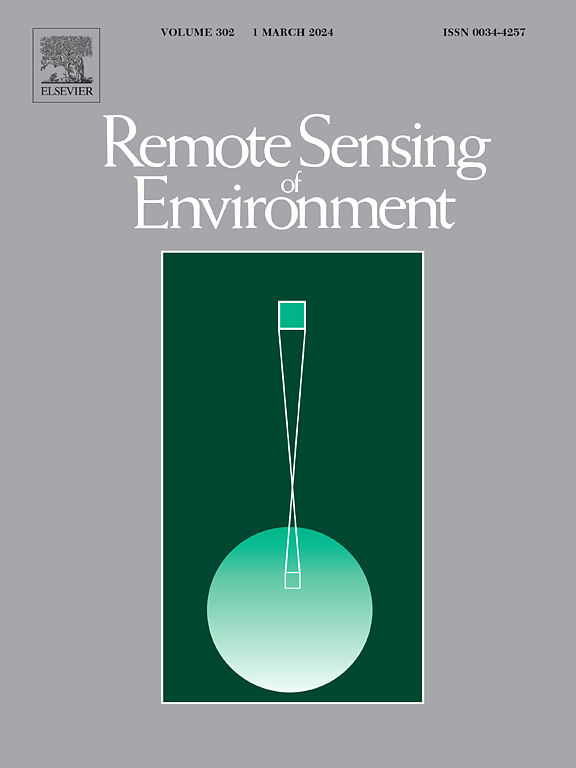A multi-parameter optimized sub-waveform retracker for monitoring river water levels using SAR altimetry
IF 11.1
1区 地球科学
Q1 ENVIRONMENTAL SCIENCES
引用次数: 0
Abstract
Synthetic Aperture Radar (SAR) altimetry has been widely used for monitoring river water levels, especially over large and medium-sized rivers. However, challenges still remain in obtaining continuous and high-precision water levels over small rivers due to the altimeter's sparse along-track sampling, distorted waveforms, and river slopes. This study presents a new multi-parameter optimized sub-waveform (MulPOS) retracker, which retracks the waveforms across all cycles through a quantitatively considered integration of the spatial consistency and temporal continuity of water levels, river slopes, and the strong reflectivity of the river surface. Firstly, along-track sampling is increased by searching for off-nadir observations within half the sampling resolution from nadir water bodies to retrieve continuous river water levels. Secondly, waveform preprocessing, including interpolation and filtering is used to determine more accurate retracking points, and then all possible sub-waveform sets that correspond to river reflections are formed. The most likely sub-waveform sets are determined by their four-parameter weighting function, which considers spatial consistency, temporal continuity of water level variations, and the high reflectivity of the river water surface. Finally, slope corrections are computed using the robust Helmert variance component estimation method by combining the differences between water levels in adjacent cycles and along the track. The MulPOS has been applied to 290 virtual stations formed by Sentinel-3A/3B and Sentinel-6 MF over rivers in the United States (52 % of which are narrower than 100 m). For comparison purposes, six other retrackers have been used, including OCOG, ICE1, threshold, NPPTR, SAMOSA+, and MWaPP+. The results have been validated against the in-situ measurements from the United States Geological Survey, indicating that the water levels derived by MulPOS are superior to other retrackers with a median RMSE of 17.9 cm, a median relative RMSE of 7.2 %, a median correlation coefficient of 0.96, and an abnormal water level occurrence rate of 0.60 %, whereas the corresponding metrics for other retrackers are >24.2 cm, >9.8 %, <0.94, and > 2.36 %. Moreover, MulPOS achieves steady and high-precision water levels across most small rivers under varying river widths (e.g., RMSE for MulPOS is 20.9 cm vs. >29.5 cm for other retrackers over rivers narrower than 50 m), varying angles between satellite ground tracks and rivers, and complex river morphologies. MulPOS is expected to generate a dataset with continuous, high-precision water level data for more small and medium-sized rivers, and this will expand the application of altimetry to inland water monitoring.
基于SAR测高的河流水位监测多参数优化子波形跟踪器
合成孔径雷达(SAR)测高技术已广泛应用于河流水位监测,特别是大中型河流水位监测。然而,由于高度计沿轨迹采样稀疏、波形失真和河流坡度,在获取小河流的连续高精度水位方面仍然存在挑战。本研究提出了一种新的多参数优化子波形(MulPOS)回溯器,该方法通过定量考虑水位、河流坡度和河流表面强反射率的空间一致性和时间连续性,对所有周期的波形进行回溯。首先,增加沿迹采样,在采样分辨率的一半范围内搜索离最低点观测值,以获取连续的河流水位。其次,对波形进行预处理,包括插值和滤波,确定更精确的重迹点,然后形成所有可能对应河流反射的子波形集。最可能的子波形集由其四参数加权函数确定,该函数考虑了水位变化的空间一致性、时间连续性和河流水面的高反射率。最后,结合相邻周期和轨道水位的差异,采用稳健Helmert方差分量估计方法计算坡度改正。MulPOS已应用于美国河流上由Sentinel-3A/3B和Sentinel-6 MF组成的290个虚拟站点(其中52%的河流宽度小于100米)。为了比较,我们使用了其他六个追踪器,包括OCOG、ICE1、threshold、NPPTR、SAMOSA+和MWaPP+。结果与美国地质调查局的原位测量结果进行了验证,结果表明,MulPOS计算得到的水位值中值RMSE为17.9 cm,中值相对RMSE为7.2%,中值相关系数为0.96,异常水位发生率为0.60%,优于其他计算方法,而其他计算方法的相应指标为>;24.2 cm, > 9.8%, <0.94, >;2.36%。此外,在不同的河流宽度(例如,在小于50米的河流上,MulPOS的RMSE为20.9 cm,而其他跟踪器的RMSE为29.5 cm)、卫星地面轨道与河流之间的角度变化以及复杂的河流形态下,MulPOS可以在大多数小河上实现稳定和高精度的水位。MulPOS有望为更多的中小河流生成具有连续、高精度水位数据的数据集,这将扩大高程测量在内陆水域监测中的应用。
本文章由计算机程序翻译,如有差异,请以英文原文为准。
求助全文
约1分钟内获得全文
求助全文
来源期刊

Remote Sensing of Environment
环境科学-成像科学与照相技术
CiteScore
25.10
自引率
8.90%
发文量
455
审稿时长
53 days
期刊介绍:
Remote Sensing of Environment (RSE) serves the Earth observation community by disseminating results on the theory, science, applications, and technology that contribute to advancing the field of remote sensing. With a thoroughly interdisciplinary approach, RSE encompasses terrestrial, oceanic, and atmospheric sensing.
The journal emphasizes biophysical and quantitative approaches to remote sensing at local to global scales, covering a diverse range of applications and techniques.
RSE serves as a vital platform for the exchange of knowledge and advancements in the dynamic field of remote sensing.
 求助内容:
求助内容: 应助结果提醒方式:
应助结果提醒方式:


